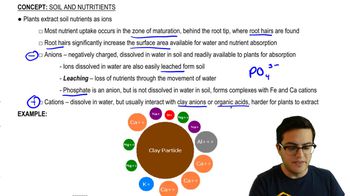35. Soil
Soil and Nutrients
Learn with other creators
Practice this topic
- Multiple ChoiceHow might roots react when they encounter a region of the soil that is low in nitrates?828views
- Multiple ChoiceThe American Dust Bowl of the 1930s resulted from __________.744views
- Multiple ChoiceSoil can easily become deficient in __________ because these ions are negatively charged and do not stick to negatively charged soil particles.1135views
- Multiple ChoiceThe particles in soil are important because they __________.1171views
- Textbook Question
The inorganic nutrient most often lacking in crops is:
a. Carbon
b. Nitrogen
c. Phosphorus
d. Potassium.
1091views - Textbook Question
Consider the following statements regarding limiting nutrients. Select True or False for each statement.
T/F Nitrogen (N), phosphorus (P), and potassium (K) are common examples.
T/F Their presence limits the availability of micronutrients.
T/F Their availability tends to limit plant growth.
T/F Certain macronutrients and micronutrients can be considered limiting nutrients.
1037views - Textbook Question
Micronutrients are needed in very small amounts because
a. Most of them are mobile in the plant
b. Most serve mainly as cofactors of enzymes
c. Most are supplied in large enough quantities in seeds
d. They play only a minor role in the growth and health of the plant
1115views - Textbook Question
Where is the start codon located?
a. At the start (5′ end) of the mRNA
b. In the DNA just upstream of where transcription starts
c. At the downstream end of the 5′ untranslated region (UTR)
d. At the upstream end of the 3′ untranslated region (UTR)
2354views



















